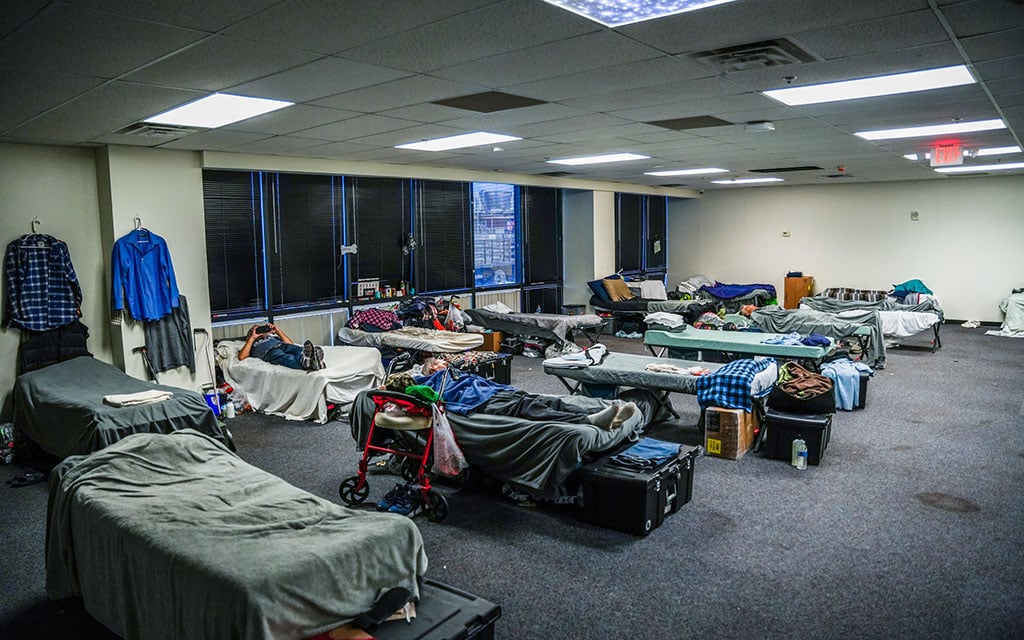
A Common Sense Institute report suggests that though most of the funding for homelessness solutions is dedicated to housing, there may be other areas to invest in as the unhoused population continues to grow. (Photo courtesy of St. Vincent de Paul)
PHOENIX – Think tank Common Sense Institute Arizona released a research study earlier this year claiming that Arizona spends as much as $1.1 billion a year on homelessness-solution services. The organization found that in 2023, approximately 14,200 people were unhoused and the number of unhoused individuals has increased by 30% since 2020.
The research estimates that the 167 nonprofit organizations providing homeless services across the state employ 9,003 people and utilize another 42,053 volunteers – a workforce that rivals the state’s mining and logging industries in terms of annual work hours.
The study suggests that though most of the funding is dedicated to housing solutions, there may be other areas to invest in as homelessness continues to grow.
“Despite this substantial financial commitment, the homeless population has not only failed to diminish over the past decade but has, in fact, increased in size,” the study said.
Tom Simplot, former director of the Arizona Department of Housing and a reviewer of the study, provided his perspective on the institute’s podcast, Common Sense Digest.
“Housing ages out of use, so not only are we losing housing, we’re not building enough housing to keep up with the current demand. And, we have growth on top of that,” Simplot said.
“Nowadays – and this has been the case now for many, many years – if affordable housing is going to be created, it’s not from the stock that exists, it is primarily from new stock that is funded primarily from federal and state governments. And that’s through low-income housing tax credits, grants and loans,” Simplot said, explaining that the current system faces difficulties due to expensive development costs for affordable housing projects, despite an increase in people who need it.
How federal, state and local dollars are allocated
Much of the funding for homelessness solutions comes from state and federal sources. The institute’s report highlights “a need to think about how we coordinate our homeless services and how we prioritize and spend finite resources to maximize impact. … While services are primarily provided by nonprofits, funding starts at the federal level and flows from federal, state, and local grantors into the nonprofit space.”
The Arizona Department of Economic Security works with nonprofit organizations and local governments to provide homelessness services across the state, according to press secretary Tasya Peterson.
The DES works alongside the U.S. Department of Housing and Urban Development’s Continuum of Care program, which looks at community-oriented solutions to ending homelessness and tracks homelessness data. According to the latest data, which uses population figures from the 2017-2021 American Community Survey, 5% of Arizonans identified as Black, African American or African. In the 2022 Point-In-Time Count, 20% of those experiencing homelessness identified as one of those racial groups, a disproportionate representation of the 13,553 people experiencing homelessness in that count.
Peterson said the DES received a HUD grant of $1.8 million 2023 federal fiscal year 2023 under the Emergency Services Grants program. The DES matched the award for a total of $4.4 million. That money is going to service providers who facilitate rapid rehousing, emergency shelters, homelessness prevention and street outreach services in different communities.
On the local level, Phoenix’s Office of Homeless Solutions focuses on shelter and heat relief, outreach, support services, prevention and more. The office has provided $140 million to homelessness solutions since July 2021, according to the city’s website.
Where more spending may be needed
The research study called out a contrast in spending on substance-abuse services and health care compared to food, clothing and shelter. The organization estimated about $318 million is spent by nonprofits annually on housing and shelter and $146 million on food and clothing. Health care spending was estimated at about $63 million and substance-abuse resources at nearly $6 million.
“Interestingly, only a marginal fraction of overall spending is dedicated to substance-abuse programs – despite extensive data suggesting the incidence of addiction issues are much higher amongst people experiencing homelessness than other populations,” the report said.
Simplot said funding for mental-health and substance-abuse services is just as important as food and housing. Though the latter are vital, rehabilitative programs can bolster the effectiveness of long-term housing solutions, he said.
“Housing-first doesn’t work across the board. It is one piece of the puzzle, one part of that continuum, one part of that spectrum. … It may be one answer in a micro-situation that may help one population,” Simplot said.
Simplot said focused funding should “provide those incentives for our behavioral-health organizations to continue to explore how they can build, develop and manage housing that will serve the needs of their behavioral-health clientele.”
